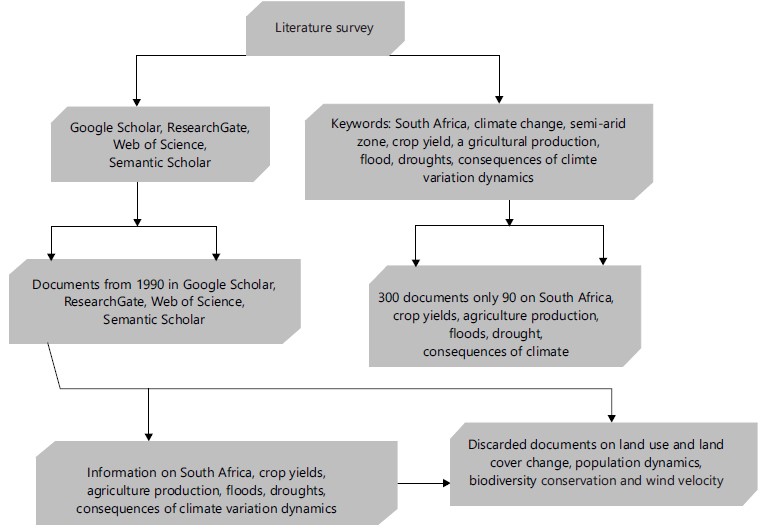Analysis of the Impacts of Climate Variations Across Semi-Arid and Arid Regions of Southeast Africa
| Received 08 Dec, 2023 |
Accepted 19 Feb, 2024 |
Published 30 Jun, 2024 |
In many semi-arid and arid countries of Southeast Africa, changing climate often linked to differential land-maritime interactions, generally influence rainfall and temperature patterns. This paper assesses climate variability and the impacts of this variability around semi-arid and arid regions of Southeast Africa. To achieve this goal, a wide review of published scientific literature was carried out with the aid of Google Scholar, ResearchGate, Web of Science and Semantic Scholar. The study found that rainfall and temperature patterns influence vegetation dynamics and evapotranspiration. In addition, changing rainfall and temperature patterns due to climate variation are deleterious to agricultural production, crop yields and household incomes and a precursor of violent inter-ethnic conflicts. Therefore, with the enforcement of proper and adequate financing, inclusion of surrounding communities in land use management plans and support and cooperation from law enforcement, land use management can respond effectively to these climate-induced threats.
INTRODUCTION
Climate variability is often referred to as the variation in the statistical distribution of a given region’s average weather conditions with respect to time. In many areas across the globe, climate variations are usually in the form of extreme weather events. These include erratic and heavy rains, increases in temperatures, reduced groundwater level and surface albedo1,2. These changing weather conditions often result in declining soil productivity, floods, droughts, storms, low crop yields, irregular on-set and end of rainy season and increased incidences of pests and diseases3,4.
Due to complex maritime and terrestrial interactions, declining annual rainfall has been observed across Africa since the end of the 1960s. This has been mainly a decrease of 20 to 40% between the periods 1931-1960 and 1968-1990. Similarly, increased interannual variability in the post-1970 period, with higher rainfall anomalies and more intense and widespread droughts has also been recorded1,5.
Other studies6,7 observed that mean temperatures across Southern Africa have slightly increased since 1960. For instance, the average number of very cold days reduced from 1961 up to 2000. During the same period, this decrease in very cold days has been parallelly accompanied by an increase in extreme hot weather events.
For instance, in the Sahel region, variations in climate have led to severe cases of famine, rainfall variability and degradation of the environment. Here, these variations or environmental shocks have great impacts because the region relies heavily on rainfed pastoralism and agriculture8,9. Although resilience and resistance to climate variations are dependent on socioeconomic status, time and location, variations generally affect agricultural production particularly crop yields, food prices and hence farming household income10,11.
This study aims at serving as a base point for policymakers within the forestry sector, national government and local forest dwelling communities to effectively collaborate in designing forest conservation and sustainable livelihood programs geared towards curtailing forest loss, deforestation, forest degradation and rural poverty. The benefits accrued from this effective collaboration would be crucial in providing local forest dwelling communities with essential support services such as wood for artisanal uses, fuelwood, traditional medicines, shelter, various habitats for plants and animals and safety nets for the fight against climate change impacts.
Methodology of the study: Such as to obtain a wide and in-depth insight into vegetation cover dynamics and climate variability across semi-arid regions of Southern Africa, a broad study of available offline and online scientific publications was carried out using Google Scholar, ResearchGate, Web of Science, Mendeley and Semantic Scholar Mendeley. Different keywords applied included Southeast Africa, climate change, semi-arid zones, crop yields, agricultural production, floods, droughts and consequences of climate variation dynamics. Southern Africa is the region of interest while consequences of climate variation dynamics are being examined. To obtain this information, both online and offline information and various other scientific publications for a period of over 25 years were selected and assessed such as to obtain a wide and exhaustive repertoire. Over 300 documents were retrieved which were then successively differentiated into semi-arid zones, crop yields, agricultural production, floods, droughts, consequences of climate variation dynamics and agricultural sector in Southern Africa.
From a wider perspective, solely documents pertaining to semi-arid zones, crop yields, agricultural production, floods, droughts, consequences of climate variation dynamics, agricultural sector in Southeast Africa, were examined. Most of the documents retrieved were on subjects not relevant to the selected categories of this study.
For example, documents involving studies on land use, land cover change, population dynamics, biodiversity conservation and wind velocity were discarded. From the about 300 documents retrieved, over 90 directly or indirectly studied crop yields, agricultural production, floods, droughts and consequences of climate variation dynamics in semi-arid and arid zones of Southern and Eastern Africa. An estimated 70% of these retrieved documents had examined different regions such as the Sahel, West Africa, Asia, Europe, Eastern Australia and Northwestern America. There was little information from around the semi-arid regions of South and East Africa as shown in Fig. 1.
The information obtained from the various publications and documents was employed in elaborating a generalized narrative of the consequences of climate variation dynamics in semi-arid zones of Southeast Africa.

|
Climate variability in Southeastern Africa: In many semi-arid countries of Southeast Africa, rainfall, evapotranspiration and annual temperatures have been changing. These changes often linked to differential land-maritime interactions, are known to generally influence vegetation distribution and plant species diversity1,12. Often attributed to changes in rainfall patterns, amount and shifts in thermal and wind regimes, this variation modifies local seasonal and annual water balances. These seasonal and annual water balances in turn influence the periodic distribution for which temperature and moisture conditions permit plant growth13.
For example, over the past two decades, Malawi has witnessed extreme weather events particularly variations in rainfall and temperature which cause frequent droughts and floods 4. Similarly, annual temperatures are expected to increase by 1.9 in 2060 with a likely increase in drought risks14. These extreme weather events partly result from the country being in the Great African Rift Valley, bourgeoning population, rapid deforestation, underdeveloped farming technology, environmental degradation and unsustainable urbanization patterns15.
According to Fandjinou et al.16, evapotranspiration and rainfall strongly correlate with Normalized Difference Vegetation Index (NDVI). Their study concluded that at both local and national scales, plant activities are influenced by evapotranspiration, NDVI and annual temperatures. Furthermore,1,17,18 affirmed that intra-seasonal factors such as timing of the onset of first rains, duration of the rains during the growing season and the effectiveness of the rains in each precipitation event, all affect vegetation dynamics. Here, changes in rainfall amount and patterns also affect soil erosion rates and soil moisture, both of which are important for vegetation growth and crop yields.
According to Salih et al.19 and Schneider et al.20, between 2019 and 2020, the desert locust (Schistocerca gregaria) invaded several countries across East Africa which was disastrous to the food security and livelihood needs of local communities. The fact that these desert locusts feed on a wide variety of crops, fruit trees, shrubs, herbs and even grasses, the impact on food security for both humans and animals (domestic and wild) was put into peril. Here, an estimated 70000 ha of croplands across Ethiopia and Somalia as well as 2400 km of arable lands in Kenya were destroyed. In Kenya alone, field assessments estimate damages and destruction due to locusts at, 41000, 36000 and 114000 ha, respectively for maize, wheat and sorghum between December, 2019 and March, 2020.
This invasion and outbreak are linked to increased frequencies of extreme weather events and anthropogenic climate change21. Here, an increase in rainfall and temperature as well as severe winds across desert areas create favourable niches for pest breeding, development and migration. Therefore, climate variability plays a major role in creating the necessary conditions for the development, outbreak and survival of these desert locusts19,21.
In related studies, Roxy et al.22 and Murakami et al.23 observed oceans absorb over 90% of global anthropogenic heat. Accordingly, for a mean summer increase of 1.2°C, the western part of the Indian Ocean has become the most rapidly warming ocean within tropical systems24. This has led to a hike in the frequency as well as the intensity of extreme weather events across the surrounding regions22,23. This has increased the number of powerful cyclones to hit the East African coast, Somalia and Mozambique. For instance, as tropical Cyclone Idai hit the Mozambican City of Beira in March, 2019, it moved across to neighboring countries, particularly Malawi and Zimbabwe. This led to severe flooding along the southern and central regions of Malawi where an estimated 71000 ha of cropped land were destroyed25.
The Malawi Vulnerability Assessment Committee (MVAC) forecasted that over 2.8 million people corresponding to an estimated 17% of the national population located in 17 flood-affected districts were not able to meet their food requirements between April 2015 and March 2016. Meanwhile, about 6.5 million people or an estimated 39% of the national population in 24 drought-affected districts could not meet their food needs during the April, 2016 and March, 2017 period26.
From a general perspective, increasing cyclone events are thought to have led to the wettest rainy season ever recorded across East Africa in 2019. For example, the capital of Djibouti experienced its rainiest period in history with 336 mm of rainfall in just four days27. This amount of rainfall received in just four days is usually experienced across two years. According to Salih et al.19, events of this nature are likely to recur in the next decades especially as a 1.5°C increase in regional climate is envisaged. Therefore, as extreme weather events recurrent, there is a likelihood of more pests and disease outbreaks. Thus, aside from the negative effects of stormy weather and extreme climate events, food security and livelihoods would be compromised28. Meanwhile, climate impacts are not solely a consequence of average temperature but also revolve around increases and frequent extreme weather events20,27.
Although, changes in climatic patterns are experienced over long-term periods, changes in the intensity of extreme weather events and their frequency are felt over short-term periods. These changes in climatic patterns have generalized food security and livelihood implications. As severe droughts are already affecting agriculture, planting and animal-rearing adaptation and mitigation are the sole options for local communities7,29,30. Across Southeast Africa, various political, social, economic and biophysical conditions expose the region to climate vagaries. In the region, aside from increasing temperatures, climate variations lead to changes in rainfall duration, amount of rainfall in every rainy event, rainfall intensity and the number of rainy days1,30,31.
Similarly, previous studies13,32,33 found increasing incidences of extreme weather events including severe floods and droughts to be related to climate vagaries. Meanwhile, previous researchers29,30,34 observed increasing desertification and changes in several biophysical traits of major disease vectors. These changes have led to differential changes in the spatiotemporal transmissions of various infectious diseases across the region.
The fact that about 70% of the livelihoods of Africans are reliant on rain-fed agriculture, climate variability greatly affects food security. This is due to the adverse effects of climate vagaries on agricultural activities in the form of shortening and disruption of the growing season, decreasing areas favorable for agriculture and reduction in agricultural yields across many countries of Southeast Africa1,3,35. In Zambia, Dumenu and Takam36 found several households affected by droughts to have experienced a 20% decrease in annual maize yields and 37% decrease in household income. Similarly, Micheler et al.37 espoused that climate vagaries such as drought reduced household maize yields by 50-80% in Zimbabwe.
Wineman et al.38 indicated that farming households that experienced droughts also witnessed a 29% reduction in their annual household income per capita. Around the Bobirwa District of Botswana39 found the major causes of poor yields in rainfed agriculture to be water scarcity and drought. Here, consequences included a lack of vegetation, little or no rains, excessively high average temperatures, death of livestock and a drastic drop in livestock fertility and products. These prevailing climatic conditions have led to a drop in household consumption and income with social ramifications spiralling into alcohol and drug abuse, increased criminality and public disorder39,40. Across several areas of Northern Kenya such as Isiolo County, scarcity of water and persistent droughts have spiraled into violent inter-ethnic conflicts, razing of homesteads and theft of livestock.
CONCLUSION
Across many countries located in semi-arid and arid zones of Southeast Africa, climate variations due to differential land-maritime interactions, have been influencing changes in rainfall and temperature patterns. These changes spiral into changing farming periods, seasons and crop types due to recurrent extreme weather events such as floods, storm squalls, droughts, locust swamps and heavy winds. As extreme weather events become more frequent across the region, these affect households that are highly dependent on rain-fed agriculture thus threatening rural households’ income and food security. This study further observed that across the region, climate variations are indirect precursors of violent inter-ethnic conflicts. Therefore, in these recurrent extreme weather events, regional governments and policymakers in the climate sector should develop multi-hazard early warning signals and systems. These systems should involve vast forecasting processes and broadcast and rapid response mechanisms such as to curb disasters and potential extreme weather impacts.
SIGNIFICANCE STATEMENT
This paper assesses climate variability and the impacts of this variability around semi-arid and arid regions of Southeast Africa. This study will serve as a baseline for policymakers in the agricultural sectors, local communities and national governments to drive effective collaboration and development in curtailing the consequences of climate variation in Southeast Africa. The accrued benefits because of this collaboration would be essential in providing the most appropriate and necessary support geared towards improving on the threats arising from climate vagaries.
REFERENCES
- Beckline, M., S. Yujun, S. Ayonghe, O.L. Etta, I. Constantine and T. Richard, 2016. Adaptation of women to climate variability in the southern slopes of the Rumpi Hills of Cameroon. Agric. For. Fish., 5: 272-279.
- Ibe, G.O., 2018. Climate variation, its impact on non timber forest products and livelihood of Ohafia people, Abia State Nigeria. Global J. Agric. Sci., 17: 91-107.
- Maganga, A.M., L. Chiwaula, P. Kambewa, 2021. Climate induced vulnerability to poverty among smallholder farmers: Evidence from Malawi. World Dev. Perspect., 21.
- Azzarri, C. and S. Signorelli, 2020. Climate and poverty in Africa South of the Sahara. World Dev., 125.
- Hope, K.R., 2009. Climate change and poverty in Africa. Int. J. Sustainable Dev. World Ecol., 16: 451-461.
- Christensen, J.H., T.R. Carter, M. Rummukainen and G. Amanatidis, 2007. Evaluating the performance and utility of regional climate models: The PRUDENCE project. Clim. Change, 81: 1-6.
- Ngoe, M., L. Zhou, B. Mukete and M. Enjema, 2019. Perceptions of climate variability and determinants of farmers’ adaptation strategies in the highlands of Southwest Cameroon. Appl. Ecol. Environ. Res., 17: 15041-15054.
- Giannini, A., P.K. Krishnamurthy, R. Cousin, N. Labidi and R.J. Choularton, 2017. Climate risk and food security in Mali: A historical perspective on adaptation. Earth's Future, 5: 144-157.
- Nébié, E.K.I., D. Ba and A. Giannini, 2021. Food security and climate shocks in Senegal: Who and where are the most vulnerable households? Global Food Secur., 29.
- Sawe, J., C.G. Mung’ong’o and G.F. Kimaro, 2018. The impacts of climate change and variability on crop farming systems in Semi-Arid Central Tanzania: The case of Manyoni District in Singida Region. Afr. J. Environ. Sci. Technol., 12: 323-334.
- Kinda, S.R. and F. Badolo, 2019. Does rainfall variability matter for food security in developing countries? Cogent Econ. Finance, 7.
- Sonwa, D.J., A. Dieye, E.H. El Mzouri, A. Majule and F.T. Mugabe et al., 2017. Drivers of climate risk in African agriculture. Clim. Dev., 9: 383-398.
- Ndiaye, G., S. Fang and B. Mukete, 2018. Analysis of market liberalization and the groundnut sector in Senegal. Int. J. Appl. Agric. Sci., 4: 43-51.
- McLaughlin, S.M., M. Bozzola and A. Nugent, 2023. Changing climate, changing food consumption? Impact of weather shocks on nutrition in Malawi. J. Dev. Stud., 59: 1827-1848.
- Dewa, O., D. Makoka and O.A. Ayo-Yusuf, 2023. Measuring community flood resilience and associated factors in rural Malawi. J. Flood Risk Manage., 16.
- Fandjinou, K., K.B. Zhang, F. Folega, B. Mukete, X.H. Yang, K. Wala and K. Akpagana, 2017. Analysis of climate variability and its relations to vegetation dynamics in Togo, Western Africa from 1984 to 2017. Appl. Ecol. Environ. Res., 17: 6761-6781.
- Mongi, H., A.E. Majule and J.G. Lyimo, 2010. Vulnerability and adaptation of rain fed agriculture to climate change and variability in semi-arid Tanzania. Afr. J. Environ. Sci. Technol., 4: 371-381.
- Müller, C., 2013. African lessons on climate change risks for agriculture. Annu. Rev. Nutr., 33: 395-411.
- Salih, A.A.M., M. Baraibar, K.K. Mwangi and G. Artan, 2020. Climate change and locust outbreak in East Africa. Nat. Clim. Change, 10: 584-585.
- Schneider, L., M. Rebetez and S. Rasmann, 2022. The effect of climate change on invasive crop pests across biomes. Curr. Opin. Insect Sci., 50.
- Zanna, L., S. Khatiwala, J.M. Gregory, J. Ison and P. Heimbach, 2019. Global reconstruction of historical ocean heat storage and transport. Proc. Natl. Acad. Sci., 116: 1126-1131.
- Roxy, M.K., S. Ghosh, A. Pathak, R. Athulya and M. Mujumdar et al., 2017. A threefold rise in widespread extreme rain events over central India. Nat. Commun., 8.
- Murakami, H., G.A. Vecchi and S. Underwood, 2017. Increasing frequency of extremely severe cyclonic storms over the Arabian Sea. Nat. Clim. Change, 7: 885-889.
- Roxy, M.K., K. Ritika, P. Terray and S. Masson, 2014. The curious case of Indian Ocean warming. J. Clim., 27: 8501-8509.
- Dewa, O., D. Makoka and O. Ayo-Yusuf, 2022. A deliberative rural community consultation to assess support for flood risk management policies to strengthen resilience in Malawi. Water, 14.
- Nicholas, A., 2023. Tropical cyclone freddy exposes major health risks in the hardest-hit Southern African countries: Lessons for climate change adaptation. Int. J. Surg.: Global Health, 6.
- Cai, W., G. Wang, B. Dewitte, L. Wu and A. Santoso et al., 2018. Increased variability of Eastern Pacific El Niño under greenhouse warming. Nature, 564: 201-206.
- Beckline, M. and M.S. Kato, 2014. Assessing the impact of consumer behaviour on food security in South West Cameroon. J. Food Secur., 2: 87-91.
- Skendžić, S., M. Zovko, I.P. Živković, V. Lešić and D. Lemić, 2021. The impact of climate change on agricultural insect pests. Insects, 12.
- Connolly-Boutin, L. and B. Smit, 2016. Climate change, food security, and livelihoods in Sub-Saharan Africa. Reg. Environ. Change, 16: 385-399.
- Kebede, A., A. Hasen and W. Negatu, 2010. Comparative analysis of vulnerability of pastoralists and agro-pastoralists to climate change: A case study in Yabello Woreda of Oromia Region, Ethiopia. Ethiop. J. Dev. Res., 32: 61-95.
- Songok, C.K., E.C. Kipkorir, E.M. Mugalavai, A.C. Kwonyike and C. Ng’weno, 2011. Improving the Participation of Agro-Pastoralists in Climate Change Adaptation and Disaster Risk Reduction Policy Formulation: A Case Study from Keiyo District, Kenya. In: Experiences of Climate Change Adaptation in Africa, Filho, W.L. (Ed.), Springer, Berlin, Heidelberg, ISBN: 978-3-642-22315-0, pp: 55-68.
- McCarthy, N., T. Kilic, J. Brubaker, S. Murray and A. de la Fuente, 2021. Droughts and floods in Malawi: Impacts on crop production and the performance of sustainable land management practices under weather extremes. Environ. Dev. Econ., 26: 432-449.
- Sarr, B., 2012. Present and future climate change in the semi-arid region of West Africa: A crucial input for practical adaptation in agriculture. Atmos. Sci. Lett., 13: 108-112.
- Amare, M., N.D. Jensen, B. Shiferaw and J.D. Cissé, 2018. Rainfall shocks and agricultural productivity: Implication for rural household consumption. Agric. Syst., 166: 79-89.
- Dumenu, W.K. and X.T. Tiamgne, 2020. Social vulnerability of smallholder farmers to climate change in Zambia: The applicability of social vulnerability index. SN Appl. Sci., 2.
- Michler, J.D., K. Baylis, M. Arends-Kuenning and K. Mazvimavi, 2019. Conservation agriculture and climate resilience. J. Environ. Econ. Manage., 93: 148-169.
- Wineman, A., N.M. Mason, J. Ochieng and L. Kirimi, 2017. Weather extremes and household welfare in rural Kenya. Food Secur., 9: 281-300.
- Rao, N., E.T. Lawson, W.N. Raditloaneng, D. Solomon and M.N. Angula, 2019. Gendered vulnerabilities to climate change: Insights from the semi-arid regions of Africa and Asia. Clim. Dev., 11: 14-26.
- Lori, T., M.K. Ditlhogo M.P. Setshogo and P. Koosaletse-Mswela, 2019. Classification, description and mapping of the vegetation in Khutse Game Reserve, Botswana. Botswana J. Agric. Appl. Sci., 13: 8-23.
How to Cite this paper?
APA-7 Style
Mukete,
B., Lori,
T., Mukete,
T., Mukete,
N. (2024). Analysis of the Impacts of Climate Variations Across Semi-Arid and Arid Regions of Southeast Africa. Asian Science Bulletin, 2(2), 105-111. https://doi.org/10.3923/asb.2024.105.111
ACS Style
Mukete,
B.; Lori,
T.; Mukete,
T.; Mukete,
N. Analysis of the Impacts of Climate Variations Across Semi-Arid and Arid Regions of Southeast Africa. Asian Sci. Bul 2024, 2, 105-111. https://doi.org/10.3923/asb.2024.105.111
AMA Style
Mukete
B, Lori
T, Mukete
T, Mukete
N. Analysis of the Impacts of Climate Variations Across Semi-Arid and Arid Regions of Southeast Africa. Asian Science Bulletin. 2024; 2(2): 105-111. https://doi.org/10.3923/asb.2024.105.111
Chicago/Turabian Style
Mukete, Beckline, Tsholofelo Lori, Tahle Mukete, and Ngoe Mukete.
2024. "Analysis of the Impacts of Climate Variations Across Semi-Arid and Arid Regions of Southeast Africa" Asian Science Bulletin 2, no. 2: 105-111. https://doi.org/10.3923/asb.2024.105.111

This work is licensed under a Creative Commons Attribution 4.0 International License.




